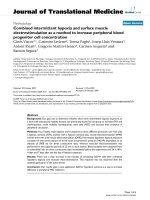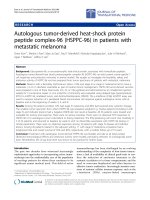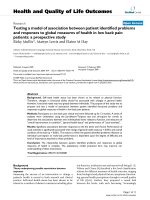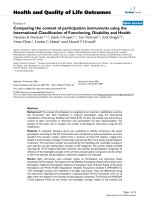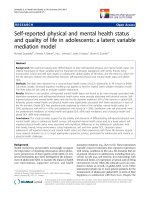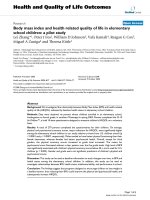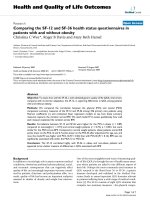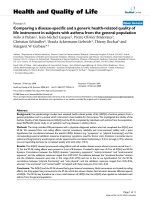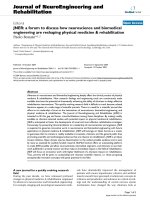báo cáo hóa học: " Comparing a disease-specific and a generic health-related quality of life instrument in subjects with asthma from the general population" pot
Bạn đang xem bản rút gọn của tài liệu. Xem và tải ngay bản đầy đủ của tài liệu tại đây (260.84 KB, 11 trang )
BioMed Central
Page 1 of 11
(page number not for citation purposes)
Health and Quality of Life
Open Access
Research
Comparing a disease-specific and a generic health-related quality of
life instrument in subjects with asthma from the general population
MiloAPuhan
1
, Jean-Michel Gaspoz
2
, Pierre-Olivier Bridevaux
3
,
Christian Schindler
4
, Ursula Ackermann-Liebrich
4
, Thierry Rochat
3
and
Margaret W Gerbase*
3
Address:
1
Department of Internal Medicine, Horten Centre for Patient-oriented Research, University Hospital of Zurich; CH-8091 Zurich,
Switzerland,
2
Department of Health and Community Medicine, Division of Community and Primary Care Medicine, University Hospitals of
Geneva, CH-1211 Geneva 14, Switzerland,
3
Department of Internal Medicine, Division of Pulmonary Medicine, University Hospitals of Geneva,
CH-1211 Geneva 14, Switzerland and
4
Institute of Social and Preventive Medicine, University of Basel, CH-4051 Basel, Switzerland
Email: Milo A Puhan - ; Jean-Michel Gaspoz - ; Pierre-Olivier Bridevaux - Pierre-
; Christian Schindler - ; Ursula Ackermann-Liebrich - Ursula.Ackermann-
; Thierry Rochat - ; Margaret W Gerbase* -
* Corresponding author
Abstract
Background: Few epidemiologic studies have assessed health-related quality of life (HRQL) of asthma patients from a
general population and it is unclear which instrument is best suitable for this purpose. We investigated the validity of the
Asthma Quality of Life Questionnaire (AQLQ) and the SF-36 completed by individuals with asthma from the population-
based SAPALDIA (Swiss study on air pollution and lung diseases in adults) cohort.
Methods: The study included 258 participants with a physician-diagnosed asthma who had completed the AQLQ and
SF-36. We assessed floor and ceiling effects, internal consistency reliability and cross-sectional validity with a priori
hypotheses that correlations between the specific HRQL domains (e.g. "symptoms" or "physical functioning") and the
corresponding external validation measures (respiratory symptoms, need for doctor visits, limitation in activities due to
asthma and lung function) would capture similar aspects and be correlated moderately (≥ 0.3) to strongly (≥ 0.5), whereas
non-corresponding domains be correlated weakly with each other (<0.3).
Results: The AQLQ showed pronounced ceiling effects with all median domain scores above 6 (scores varied from 1–
7). For the SF-36, ceiling effects were present in 5 out of 8 domains. Cronbach's alpha was >0.7 for all AQLQ and SF-36
domains. Correlations between the AQLQ domains "respiratory symptoms", "activity limitation" and "environmental
exposure", and the validation measures ranged from 0.29–0.57. Correlations between the "emotional function" domain
and the validation measures were also in this range (0.31–0.55) and not as low as we hypothesized. For the SF-36,
correlations between "physical functioning" and "role physical", and the validation measures ranged from 0.25–0.56,
whereas "role emotional" and "mental health" correlated with these measures from 0.01–0.23.
Conclusion: The AQLQ and the SF-36 showed fairly good internal consistency. Both instruments are limited by ceiling
effects, but they appear less pronounced in the SF-36, which also shows a better discrimination between different aspects
of HRQL. The SF-36 may therefore be a more valid measure of HRQL than the AQLQ when applied to individuals with
asthma from the general population.
Published: 15 February 2008
Health and Quality of Life Outcomes 2008, 6:15 doi:10.1186/1477-7525-6-15
Received: 19 October 2007
Accepted: 15 February 2008
This article is available from: />© 2008 Puhan et al; licensee BioMed Central Ltd.
This is an Open Access article distributed under the terms of the Creative Commons Attribution License ( />),
which permits unrestricted use, distribution, and reproduction in any medium, provided the original work is properly cited.
Health and Quality of Life Outcomes 2008, 6:15 />Page 2 of 11
(page number not for citation purposes)
Introduction
In asthma research, there is growing evidence indicating
that traditional outcomes, such as respiratory symptoms
and pulmonary function, do not entirely express the
patients' perception of the limitation determined by this
condition [1]. Assessment of health-related quality of life
(HRQL) has become central to assess the self-perceived
impact of physical and mental impairment on patients'
health [2]. However, reports on HRQL from subjects with
asthma from the general population are scarce.
To date, more than a hundred randomised trials have
reported the beneficial effects of a variety of therapeutic
interventions to reverse airway obstruction and respira-
tory symptoms in patients with asthma, but very few stud-
ies have assessed HRQL parameters [3-5]. In addition,
HRQL has been rarely investigated in non selected indi-
viduals with asthma from the general population, who
may differ substantially from patients selected for clinical
trials [6].
To assess HRQL of the universe of subjects with asthma,
observational population-based studies are by design less
prone to the restrictive selection criteria of clinical trials
and are more suitable to provide valid effect estimates that
can be applied to the "real" world setting [7-9]. A require-
ment is, however, to have a valid HRQL instrument. One
of the most widely used instruments to assess self-per-
ceived asthma is the disease-specific Asthma Quality of
Life Questionnaire (AQLQ)[10]. Disease-specific instru-
ments are known to be more sensitive to assess changes
within patients [11,12]. On the counterpart, generic
instruments such as the Short-Form Survey 36 (SF-36) are
less sensitive to assess intra-individual changes, but are
specifically designed to detect differences between indi-
viduals from a general population [13].
It is unclear whether the AQLQ or the SF-36 is the best
choice for asthma patients enrolled in population-based
studies. The measurement properties of the HRQL instru-
ments depend substantially on the population under
study. Therefore, the aim of our study was to investigate
the measurement properties of the AQLQ and the SF-36
completed by individuals with asthma from the popula-
tion-based SAPALDIA (Swiss Study on Air Pollution and
Respiratory Diseases in Adults) cohort.
Methods
A priori considerations
We postulated that, in order to be useful for epidemio-
logic studies, the AQLQ or SF-36 should fulfil the follow-
ing requirements. First, the AQLQ and SF-36 should
discriminate well amongst patients with different degrees
of impairment. For this specific purpose they should show
a wide distribution of scores with low ceiling effects and
good cross-sectional validity. Second, the domain scores
of the questionnaire should adequately express the infor-
mation contained in its single items. For this purpose, we
analysed measures of internal consistency reliability.
Finally, we assessed the acceptability of the questionnaires
by calculating the extent of missing items within each
HRQL instrument. The analysis of measurement proper-
ties requiring a longitudinal assessment were beyond the
scope of this study.
The SAPALDIA study
We reported on the methods of the SAPALDIA cohort
study in detail previously [14,15]. Briefly, the SAPALDIA
cohort constitutes of a random sample of 9651 adults
recruited initially in 1991. Eight study areas (Geneva,
Basel, Lugano, Aarau, Wald, Payerne, Davos, Montana)
were chosen to represent the geographic, environmental
and cultural diversity of Switzerland. A random sample of
persons aged 18–60 years, who had been residents in the
respective area for at least three years, were drawn from
the local registries of inhabitants of these areas. Health
examinations were conducted at the eight local centres at
baseline in 1991 and at follow-up in 2002. Subjects
answered an interview-based standardised questionnaire,
adapted from the European Community Respiratory
Health Study [16] and to the Short-form 36 questionnaire
[13]. In addition, participants with asthma were invited to
complete the Asthma Quality of Life Questionnaire [10].
Spirometry meeting the American Thoracic Society criteria
was performed at both surveys. For this study, spirometry
parameters (FVC, FEV
1
and FEF
25–75
) obtained during the
follow-up survey in 2002 were used for analyses. Ethical
approval was obtained from the Swiss Academy of Medi-
cal Sciences and the Regional Ethics Committees. Written
informed consent was obtained from all participants at
both surveys.
Inclusion criteria for analysis
We identified all adults with asthma from the SAPALDIA
cohort who had completed the AQLQ at the second sur-
vey in 2002. The diagnosis of asthma was based on the
answer "yes" to the following questions: "Do you have
asthma?" and "Has your asthma been diagnosed by a doctor?"
HRQL instruments
The AQLQ is a disease-specific instrument and addresses
physical and mental impairment commonly related to
asthma [10]. It consists of four domains "symptoms" (12
items), "activity limitation" (11 items), "emotional func-
tion" (5 items) and susceptibility to "environmental expo-
sure" (4 items). Domain scores are calculated as the
average of the items within each domain and presented
on a Likert-type scale varying from 1 (most severe impair-
ment) to 7 (no impairment).
Health and Quality of Life Outcomes 2008, 6:15 />Page 3 of 11
(page number not for citation purposes)
The SF-36 is the most widely used generic HRQL instru-
ment and has been used frequently in observational stud-
ies as well as in clinical trials [13]. The 36 items cover a
broad range of symptoms and limitations. The eight
domain scores are generated from 2–10 items and
expressed on a scale varying from 0–100. For some
domains such as the "role physical" domain, scores range
from 0–100 but only the scores 0, 25, 50, 75 and 100 are
possible. Two summary scores (physical and mental com-
ponent summary score) can be derived from the domain
scores. The component summary scores are standardized
(t scores) to have a mean value of 50 for the general pop-
ulation with a standard deviation of 10.
Validation measures
We used a number of validation measures available from
the SAPALDIA database that met the Global Initiative for
Asthma criteria for the assessment of asthma [17]. Data
from the SAPALDIA questionnaire included information
on regular visits to medical doctors (general practitioner
and pulmonologist) due to asthma-related symptoms
during the 12 months preceding the SAPALDIA examina-
tion [18,19]. For "respiratory symptoms", answers on the
presence of wheeze, cough (day or night), phlegm (day or
night) and dyspnea were computed as a simple cumula-
tive score varying between 0 and 4 to indicate the number
of reported symptoms [20]. The SAPALDIA questionnaire
includes a question about the avoidance of physical activ-
ity due to asthma ("exercise limitation"). Information
about "professional and leisure limitation due to asthma"
was covered by items such as inability to work, sick leaves
or limitations of leisure time activities because of asthma.
Other validation measures included information on the
subjects' smoking status, spirometry results (percent of
predicted FEV
1
and FEF
25–75
), as well as patients' self-
reported and physician-diagnosed depression. In the
SAPALDIA survey, answers to symptom questions
included 4 options (yes, no, don't know and refuse to
answer). Missing answers were considered when none of
the 4 options was selected by the participant.
Statistical analysis
We first determined the extent of missing data for each
item of the two questionnaires. We then assessed the dis-
tributions of the AQLQ and SF-36 domain scores graphi-
cally and by looking at skewness and kurtosis. Since
AQLQ and SF-36 scores were skewed towards high scores
and not distributed normally, we calculated medians and
interquartile ranges (25
th
to 75
th
percentile) and used non-
parametric tests.
In order to determine floor and ceiling effects, we calcu-
lated the percentage of patients with very low and very
high scores. Since there is no consensus on how to define
floor and ceiling effects mathematically, we determined a
priori that floor and ceiling effects were present when the
AQLQ domain scores were found between 1 and 2, and 6
and 7, respectively, and when the SF-36 domain scores
were found between 0 and 10, and 90 and 100, respec-
tively.
For internal consistency reliability, we used three meas-
ures: corrected item-total correlations, inter-item correla-
tions and Cronbach's alpha. Corrected item-total
correlations indicate the extent to which each item relates
to the construct measured by the total score. Correcting
the total score by removing the item of interest prevents
spuriously high values due to item overlap. A recom-
mended minimum value is 0.40 [21]. Inter-item correla-
tions represent the mutual relation between individual
items and should exceed 0.3 [21]. We also calculated the
Cronbach's alpha coefficient to further assess internal
consistency. Cronbach's alpha should exceed 0.7 [21]. In
the absence of a gold standard, the most widely estab-
lished method to investigate validity is the correlation
approach, which allows to assess dissimilarities and com-
plementarities between instruments [2,22]. To assess this,
we hypothesized a priori that correlations (Spearman
rank correlation coefficients) of specific AQLQ and SF-36
domains representing physical impairment (e.g. "symp-
toms" or "physical functioning") should correlate moder-
ately (correlation coefficients ≥ 0.3) to strongly (≥ 0.5)
with validation measures capturing similar aspects ("res-
piratory symptoms" or "professional and leisure limita-
tion due to asthma"). Non-corresponding domains (e.g.
AQLQ domain for "symptoms" and presence of "depres-
sion") should correlate weakly with each other (<0.3).
Accordingly, AQLQ and SF-36 domains representing
mood or psychological status ("emotional function" or
"role emotional") should correlate moderately to strongly
with self-reported or doctor-diagnosed "depression" and
only weakly with validation measures for physical impair-
ment ("respiratory symptoms" or "airflow obstruction").
We assumed cross-sectional validity to be sufficient if the
observed correlations corresponded to our hypothesized
correlations. Finally, we performed sensitivity analysis
restricted to the subset of subjects who reported an exacer-
bation of asthma in the period preceding the SAPALDIA
follow-up visit, to investigate whether the HRQL scores
were lower and the cross-sectional validity was different in
these individuals, as compared to the whole cohort. For
the purpose of this analysis, subjects included in the sub-
group with exacerbation of asthma were defined by the
reports of regular use of asthma medication in the three
months preceding the follow-up SAPALDIA survey in
2002 (SAPALDIA 2). We performed all statistical analyses
using SPSS 12.01 for Windows (SPSS Inc, Chicago, Ill).
Health and Quality of Life Outcomes 2008, 6:15 />Page 4 of 11
(page number not for citation purposes)
Results
We identified a total of 615 individuals with asthma in the
SAPALDIA cohort who participated in the second survey.
Out of 615 subjects, we included 258 individuals (42%)
in the analyses, who had completed the AQLQ. 216 of
these subjects (84%) had also completed the SF-36. Table
1 shows the characteristics of subjects who had completed
only the AQLQ, subjects who had completed both the
AQLQ and the SF36, and subjects who had not completed
any of the HRQL instruments. Percent of predicted FEV
1
and FEF
25–75
of the participants included in the analyses
were 85.3 ± 19.0% and 69.8 ± 32.1% (mean ± SD), respec-
tively. Wheezing was reported by 60.7% of the subjects,
whereas 24.0% or less reported dyspnea, cough or
phlegm. The majority of subjects reported relatively few
asthma attacks (median number of asthma attacks 3,
interquartile range 1–12) during the 12 months preceding
the SAPALDIA 2 assessment and 55.4% of subjects denied
the use of asthma medication in the 3 months prior to the
survey.
To assess the extent of potential selection bias, Table 1
also shows the characteristics of participants who had
either completed the AQLQ only or none of the HRQL
instruments. We found that participants who refused to
complete the HRQL instruments were more likely to be
smokers and to present symptoms of cough, and less
likely to be limited by exercise and to visit a lung special-
ist. Also, subjects who refused to complete the HRQL
instruments had relatively little use of asthma medication
(12.3% during the 3 months preceding the survey),
whereas the number of asthma attacks was comparable to
those completing HRQL instruments. In addition, we
compared the presence of other co-morbidities between
groups. Frequency of systemic hypertension (22% and
26%), cardio-vascular diseases (8% and 12%), diabetes
(5% and 9%) and cancer (5% and 3%) in subjects who
answered the quality of life questionnaires and subjects
who refused to participate in these surveys, respectively,
was comparable as well.
The occurrence of missing answers was low for both ques-
tionnaires. For the AQLQ the percentage of missing
Table 1: Characteristics of participants of the SAPALDIA cohort according to the completion of the HRQL instruments
AQLQ
Group A*
AQLQ + SF36
Group B*
No AQLQ, no SF36
Group C*
Age, years ± SD 48.7 ± 14.0 47.2 ± 14.2 49.3 ± 15.5
Male gender, % 49.2 47.5 45.7
BMI, ± SD 22.3 ± 6.0 22.4 ± 6.3 20.9 ± 8.5
Low level of education, % 19.1 19.0 14.2*
Current smokers, % 17.2 17.6 27.2
†
Formers smokers, % 31.7 33.5 33.3
Never smokers, % 50.8 48.9 37.0
‡
Cough, % 20.2 16.7 27.2
§
Phlegm, % 15.3 12.2 19.8
Wheeze, % 60.7 57.0 51.9
Dyspnea, % 24.0 21.7 18.5
Depression,% 12.2 12.7 13.0
Exercise limitation, % 24.8 24.3 8.6
€
GP visits, % 34.7 33.9 27.8
Lung specialist visits, % 16.4 14.5 8.0
¥
FVC, % of predicted value ± SD 94.9 ± 14.6 96.5 ± 13.3 94.7 ± 15.0
FEV
1
, % of predicted value ± SD 85.3 ± 19.7 87.1 ± 18.4 90.2 ± 16.5
FEF
25–75
, % of predicted value ± SD 69.8 ± 32.1 71.1 ± 30.8 81.7 ± 26.8
Use of asthma medication during last 3 months,% 38.8 32.5 12.3
€
Number of asthma attacks in last 12 months, median
(25
th
to 75
th
percentile)
3 (1–12) 3 (1–12) 3 (1–10)
Number of asthma attacks in last 3 months, median
(25
th
to 75
th
percentile)
2 (1–7) 2 (1–6) 2 (1–4)
Group A: Participants who had completed the Asthma quality of life questionnaire (AQLQ) only; group B: participants who had completed the
AQLQ and the short-form 36 questionnaire (SF36); group C: participants who had not completed the AQLQ nor the SF36.
BMI: body mass index; GP: general practitioner; FVC: forced vital capacity; FEV
1
: forced expiratory volume at one second; FEF
25–75
: forced
expiratory flow measured between 25% and 75% of the forced vital capacity. *p = 0.01 and p < 0.05 compared to groups A and B, respectively;
†
p =
0.01 and p < 0.05 compared to groups A and B, respectively;
‡
p < 0.01 and p < 0.05 compared to groups A and B, respectively;
§
p = 0.01 compared
to group B;
€
p < 0.0001 compared to groups A and B;
¥
p = 0.01 and p = 0.05 compared to groups A and B, respectively.
Health and Quality of Life Outcomes 2008, 6:15 />Page 5 of 11
(page number not for citation purposes)
answers per item was below 3% for 31 of the 32 items.
However, in one single item (number 5, "being troubled
by asthma during the night") the rate of missing answers
was 7%. For the SF-36, less than 3% missing answers was
found for each of the 36 items.
For the AQLQ domains, median scores were all above 6
and more than 75% of all respondents had scores above 5
(Table 2). Figure 1 shows this pronounced ceiling effect.
For the SF-36, ceiling effects were also present in the
"physical functioning", "role physical", "bodily pain",
"social functioning" and "role emotional" domains. The
"general health", "vitality" and "mental health" domains
showed almost normal distributions.
Cronbach alpha was above 0.7 for all AQLQ and SF-36
domains (Table 2). Corrected item-total and inter-item
correlations were also high with few exceptions. Table 3
shows the correlations between the AQLQ and SF-36 that
were, in general, moderate to high. Correlations were not
lower between domains that are supposed to measure dif-
ferent constructs. For example, correlations of the "physi-
cal functioning" domain of the SF-36 were high with all
four AQLQ domains.
Table 4 shows the correlations to investigate cross-sec-
tional validity of the two questionnaires. Correlations of
the "symptoms", "activity limitation" and "environmen-
tal exposure" domains of the AQLQ with "exacerbation of
asthma", "respiratory symptoms", "exercise limitation"
and "professional or leisure limitation" were moderate to
high, as hypothesized. Correlations were similarly high
for the "emotional function" domain and substantially
higher than we hypothesized a priori. In turn, the AQLQ
"emotional function" domain correlated only weakly
with "depression" as did the "symptoms", "activity limita-
tion" and "environmental exposure" domains.
The SF-36 domains assessing physical impairment ("phys-
ical functioning" and "role physical") correlated substan-
tially higher with the external validation measures than
the domains evaluating mental impairment ("role emo-
tional" and "mental health"). On the other hand, "vital-
ity", "role emotional" and "mental health" correlated
better with "depression" than the SF-36 domains assess-
ing physical impairment.
In the subgroup of subjects defined as having an exacerba-
tion of asthma at the interview in 2002 (n = 143), the
Table 2: Scores of the AQLQ and the SF-36 in individuals with asthma from a general population
Instrument Number of
items
Median scores
(25th to 75th
percentile)
Floor and ceiling effects Internal consistency reliability
% scores 1–2 % scores 6–7 Cronbach
alpha
Corrected
item total
correlations
Inter-item
correlation
AQLQ (n = 258)
Symptoms 11 6.38 (5.33–6.92) 0.4 72.1 0.92 0.47–0.86 0.22–0.89
Activity limitation 12 6.36 (5.64–6.91) 0.4 60.9 0.95 0.64–0.86 0.40–0.79
Emotional function 5 6.80 (5.80–7.00) 0.4 64.0 0.84 0.53–0.76 0.37–0.70
Environmental exposure 4 6.50 (5.25–7.00) 0.4 66.7 0.77 0.50–0.64 0.34–0.56
% scores 0–
10
% scores 90–
100
SF-36 (n = 216)
Physical functioning 10 90.0 (75.0–100.0) 2.3 54.8 0.92 0.57–0.81 0.30–0.82
Role physical 4 100.0 (50.0–100.0) 10.4 66.0 0.86 0.69–0.73 0.57–0.64
Bodily pain 2 84.0 (51.0–100.0) 1.4 41.7 0.93 0.88 0.88
General health 5 58.8 (50.0–69.1) 0.5 0.5 0.77 0.38–0.71 0.22–0.66
Vitality 4 60.0 (45.0–70.0) 2.8 3.7 0.88 0.71–0.79 0.51–0.78
Social functioning 2 87.5 (62.5–100.0) 0.5 46.3 0.80 0.74 0.74
Role emotional 3 100.0 (66.7–100.0) 10.3 68.7 0.78 0.55–0.67 0.48–0.65
Mental health 5 76.0 (60.0–84.0) 0.5 11.6 0.88 0.66–0.78 0.46–0.75
Physical component score 52.4.(44.1–56.4)
Mental component score 50.8 (41.8–54.2)
AQLQ: Asthma quality of life questionnaire; SF-36: Short-form 36 questionnaire
Health and Quality of Life Outcomes 2008, 6:15 />Page 6 of 11
(page number not for citation purposes)
AQLQ domain scores were lower (median 5.75 [inter-
Distribution of AQLQ and SF-36 domain scoresFigure 1
Distribution of AQLQ and SF-36 domain scores. The figure shows the distributions of the respondents' AQLQ (Likert
type scale from 1 to 7) and SF-36 scores (from 0 to 100). For the AQLQ all domain scores are left-skewed. For the SF-36, the
"physical functioning", "role physical", "bodily pain", "social functioning" and "role emotional" domains are left-skewed. The
"general health", "vitality" and "mental health" domains showed almost normal distributions.
Asthma quality of life questionnaire
SF-36
1234567
Symptoms
0
25
50
75
0 25 50 75 100
Physical
functioning
0
25
50
75
Activity
limitation
0
25
50
75
1234567
Emotional
function
0
25
50
75
125
100
1234567
Environmental
exposure
0
25
50
75
1234567
Role
physical
0
25
50
75
100
125
0 255075100
Bodily
pain
0
25
50
75
0 255075100
General
health
0 255075100
0
10
20
30
40
0
5
10
15
20
Vitality
0 25 50 75 100
Social
functioning
0
25
50
75
100
0 25 50 75 100
0
50
100
150
Role
emotional
0 25 50 75 100
0
5
10
15
20
25
Mental
health
0 25 50 75 100
Number
of patients
Number
of patients
Domain
score
Domain
score
Table 3: Correlation between the AQLQ and the SF-36
AQLQ Symptoms Activity limitation Emotional function Environmental
exposure
SF-36
Physical functioning 0.49 0.61 0.54 0.51
Role physical 0.32 0.42 0.34 0.33
Bodily pain 0.33 0.36 0.29 0.33
General health 0.32 0.41 0.30 0.36
Vitality 0.34 0.34 0.30 0.28
Social functioning 0.34 0.36 0.34 0.29
Role emotional 0.27 0.32 0.31 0.26
Mental health 0.36 0.33 0.30 0.31
PCS 0.40 0.51 0.41 0.42
MCS 0.26 0.19 0.21 0.18
Health and Quality of Life Outcomes 2008, 6:15 />Page 7 of 11
(page number not for citation purposes)
quartile range 4.58–6.67] for "symptoms", 6.00 [5.09–
6.72] for "activity limitation", 6.20 [5.20–6.80] for "emo-
tional function" and 6.00 [4.75–6.75] for "environmental
exposure") than in the overall cohort (median scores of
6.38, 6.36, 6.80 and 6.50, respectively, see Table 2). The
SF-36 scores were also lower for this sub-sample of indi-
viduals for some domains (85.0 [63.8–95.0] for "physical
functioning", 74.0 [51.0–100.0] for "bodily pain", 55.0
[40.0–70.0] for "vitality" and 75.0 [62.5–100.0] for
"social functioning") while they were similar for the other
domains (100.0 [50.0–100.0] for "role physical", 58.8
[46.3–65.0] for "general health", 100.0 [66.7–100.0] for
"role emotional" and 76.0 [56.0–84.0] for "mental
health").
Table 5 shows, however, that the correlation coefficients
comparing domains from the two instruments and the
external validation measures were not substantially differ-
ent from the correlation coefficients calculated for the
whole study population. For example, correlation coeffi-
cients between the AQLQ "activity limitation" domain
and the several validation measures differed by less than
0.1; similarly, the correlation coefficients for the whole
cohort (Table 4) differed by ≤ 0.1 when compared to the
Table 4: Cross-sectional validity for the entire group of subjects
Instrument AQLQ
Validation
measure
Activity
limitation
Symptoms Emotional
function
Environme
ntal
exposure
Severity of asthma -0.33 -0.41 -0.38 -0.34
Respiratory
symptoms
-0.57 -0.67 -0.55 -0.57
Exercise limitation -0.40 -0.32 -0.35 -0.29
Professional or
leisure limitation
due to asthma?
-0.37 -0.35 -0.31 -0.34
Depression -0.17 -0.10 -0.09 -0.12
Smoking
Current 0.02 -0.08 -0.03 -0.06
Current or
former
-0.15 -0.10 -0.12 -0.10
FEV
1
(% of pre-
dicted value)
0.37 0.42 0.41 0.37
FEF
25–75
(% of pre-
dicted value)
0.31 0.21 0.26 0.24
SF-36
Physical
functioning
Role
physical
Bodily pain General
health
Vitality Social
functioning
Role
emotional
Mental
health
Severity of asthma -0.31 -0.25 -0.20 -0.31 -0.14 -0.19 -0.14 -0.14
Respiratory
symptoms
-0.37 -0.27 -0.28 -0.32 -0.30 -0.26 -0.21 -0.23
Exercise limitation -0.39 -0.26 -0.19 -0.18 -0.24 -0.15 -0.13 -0.13
Professional or
leisure limitation
due to asthma?
-0.30 -0.32 -0.25 -0.35 -0.22 -0.25 -0.21 -0.13
Depression -0.16 -0.24 -0.25 -0.20 -0.29 -0.25 -0.31 -0.27
Smoking
Current 0.03 0.05 -0.04 0.03 0.01 0.00 0.08 -0.02
Current or
former
-0.07 -0.10 -0.13 0.09 -0.05 -0.08 0.01 0.01
FEV
1
(% of pre-
dicted value)
0.56 0.32 0.23 0.20 0.16 0.20 0.21 0.10
FEF
25–75
(% of pre-
dicted value)
0.45 0.30 0.28 0.12 0.07 0.14 0.13 0.02
Health and Quality of Life Outcomes 2008, 6:15 />Page 8 of 11
(page number not for citation purposes)
coefficients obtained for subjects classified as having and
exacerbation of asthma (Table 5).
Discussion
Our findings show that cross-sectional validity, expressed
by the correlations between the SF-36 and AQLQ domains
and the validation measures, approached the a priori
hypothesized correlations for the SF-36 and, to a lesser
extent, for the AQLQ. Both instruments showed good
internal consistency reliability. There were few missing
items on the completed questionnaires, which indicates
satisfactory acceptability. However, both instruments
showed important ceiling effects, which seemed less
marked for the SF-36.
To our knowledge, this is the first study to assess the meas-
urement properties of the AQLQ and SF-36 in asthma
patients of a general population. The AQLQ discriminated
between patients with different disease severity as shown
by the lower domain scores found in patients presenting
an exacerbation of the disease and requiring regular use of
asthma medication. But the different domains did not dis-
criminate well between physical and emotional function-
ing domains covered by this instrument. As such,
correlations of the four AQLQ domains with validation
measures were similar although they are conceived to cap-
ture different aspects of HRQL.
Emotional function may be impaired in asthma patients
as a consequence of physical impairment and, therefore,
may also correlate with measures capturing physical
Table 5: Cross-sectional validity for individuals with an exacerbation of asthma at the follow-up survey* (n = 143)
Instrument AQLQ
Validation measure Activity
limitation
Symptoms Emotional
function
Environme
ntal
exposure
Severity of asthma -0.27 -0.34 -0.33 -0.28
Respiratory symptoms -0.49 -0.62 -0.43 -0.52
Exercise limitation -0.32 -0.39 -0.32 -0.30
Professional or leisure
limitation due to
asthma?
-0.34 -0.34 -0.24 -0.30
Depression -0.21 -0.13 -0.09 -0.15
Smoking
Current -0.05 -0.10 -0.08 -0.13
Current or former -0.08 -0.21 -0.14 -0.14
FEV
1
(% of predicted
value)
0.34 0.27 0.34 0.29
FEF
25–75
(% of pre-
dicted value)
0.24 0.12 0.21 0.18
SF-36
Physical
functioning
Role
physical
Bodily pain General
health
Vitality Social
functioning
Role
emotional
Mental
health
Severity of asthma -0.24 -0.25 -0.18 -0.25 -0.03 -0.16 -0.12 -0.12
Respiratory symptoms -0.38 -0.29 -0.31 -0.26 -0.30 -0.20 -0.20 -0.29
Exercise limitation -0.42 -0.20 -0.19 -0.16 -0.27 -0.10 -0.11 -0.18
Professional or leisure
limitation due to
asthma?
-0.34 -0.38 -0.28 -0.32 -0.19 -0.20 -0.22 -0.15
Depression -0.26 -0.25 -0.33 -0.38 -0.27 -0.38 -0.35 -0.25
Smoking
Current 0.00 0.02 -0.11 0.01 0.03 0.04 0.09 0.04
Current or former -0.11 -0.12 -0.23 0.11 -0.14 -0.12 -0.01 0.03
FEV
1
(% of predicted
value)
0.57 0.32 0.18 0.12 0.06 0.18 0.21 0.05
FEF
25–75
(% of
predicted value)
0.48 0.33 0.30 0.09 0.06 0.21 0.23 0.03
* Selection criteria are described in the Methods section
Health and Quality of Life Outcomes 2008, 6:15 />Page 9 of 11
(page number not for citation purposes)
impairment. However, one would still expect lower corre-
lations than between the "symptoms" and "activity limi-
tation" domains and validation measures for physical
impairment. If the different domains do not distinguish
between different aspects of HRQL one might argue that
the AQLQ is a valid measurement of overall HRQL but
that the domains provide redundant information. In con-
trast to the AQLQ, we observed lower correlations
between the SF-36 "role emotional" and "mental health"
domains and the validation measures for physical impair-
ment. Thus the SF-36 discriminates better between differ-
ent aspects of HRQL. A likely explanation for the lower
validity of the AQLQ is the pronounced ceiling effect. Sub-
jects of this study were, on average, barely affected by
asthma symptoms and inter-individual variability was
low with limited scope for discrimination between
patients.
Earlier validation studies of the AQLQ included asthma
patients from clinical settings, where AQLQ scores were
substantially lower and where no ceiling effect was
present [10,23-26]. However, correlations of the AQLQ
"emotional functioning" and the "symptoms" or "activity
limitation" domains with validation measures were again
similar. Our results are in line with these studies also
showing that the AQLQ did not capture different aspects
of HRQL in clinical populations.
Given the current evidence on the cross-sectional validity
of the AQLQ, it appears that this instrument discriminates
well between different degrees of asthma severity, but the
specific domains addressed by the instrument do not dis-
criminate well between different aspects of HRQL. The
reason for this remains unclear. The development and the
validation process of the AQLQ was identical to that of the
Chronic Respiratory Questionnaire, a widely used disease-
specific HRQL instrument for patients with chronic
obstructive pulmonary disease [2]. The Chronic Respira-
tory Questionnaire also discriminates well between
patients with different disease severity but its domains
also capture different aspects of HRQL [27-29]. For exam-
ple, the "dyspnea" domain correlates substantially better
with the SF-36 "physical component summary score"
than the "mental component summary score", and the
"emotional function" domain correlates better with the
SF-36 "mental component summary score" than the
"physical component summary score".
In general, disease-specific instruments have been
reported substantially more responsive than generic
instruments and may be therefore more suitable to assess
the disease impact on HRQL [11,12]. The SAPALDIA
cohort does not provide data to assess responsiveness of
the AQLQ and the SF-36. However, we could speculate
that in a general population such as our cohort, the AQLQ
would have similar responsiveness to the SF-36 due to the
ceiling effects. Thus, in population-based studies it is, in
general, difficult to assess changes over time. One possi-
bility to overcome some of the ceiling effect in popula-
tion-based studies might be to modify or increase the
number of answer options to each question addressed by
the HRQL instruments. Thereby, persons with mild dis-
ease would be able to express minimal degree of impair-
ment or recovery. However, such modifications would
require careful validation before being suitable for appli-
cation in epidemiologic studies.
A limitation of our study is that only 258 participants
completed the AQLQ, who represent approximately 40%
of all subjects with asthma from the SAPALDIA cohort
participating in the second survey. While comparing the
characteristics of participants who completed and did not
complete the HRQL instruments, we found that partici-
pants who did not complete the HRQL questionnaires
were essentially less affected by asthma. It is, therefore,
likely that inclusion of these participants would have led
to even more pronounced ceiling effects. Another limita-
tion is that we had only one external validation measure
for psychological impairment. We did not have instru-
ments such as the Hospital Anxiety and Depression Scale
or similar instruments. However, self-reported depression
was validated by an affirmative answer to a question on
doctor-diagnosed depression.
Potential strengths of our study are the number of external
validation measures for physical impairment and disease
severity, and the approach to investigate validity. The
highest level of evidence about an instrument's validity is
generated when the observed correlation coefficients meet
a priori hypothesized correlation results rather than just
looking at the correlations [2]. Moderate to strong corre-
lations per se may not represent sufficient validity. In our
study, unexpectedly high correlations existed between the
"emotional functioning" domain and the "severity of
asthma" or "respiratory symptoms" domains. If correla-
tions between such measures are found to be moderate to
strong, although they are supposed to assess different
aspects of health, it is unclear what they actually measure.
Conclusion
The results of this study show that the AQLQ and SF-36
have good internal consistency. Both instruments are lim-
ited by ceiling effects, but the negative consequences on
cross-sectional validity appear to be less pronounced for
the SF-36. Therefore, the SF-36 seems a more suitable
choice to assess HRQL in individuals with asthma from
the general population.
Health and Quality of Life Outcomes 2008, 6:15 />Page 10 of 11
(page number not for citation purposes)
Competing interests
The author(s) declare that they have no competing inter-
ests.
Authors' contributions
MAP participated in the design of the study, performed
the statistical analysis and drafted the manuscript. JMG
participated in the design of the study and revised the
manuscript. POB participated in the design of the study
and revised the manuscript. CS participated in the design
of the study, reviewed the statistical analysis and revised
the manuscript. UAL participated in the design of the
study and revised the manuscript. TR participated in the
design of the study and revised the manuscript. MWG par-
ticipated in the design of the study, performed the statisti-
cal analysis and revised the manuscript. All authors read
and approved the final manuscript.
Acknowledgements
SAPALDIA Team (Swiss cohort study on air pollution and respiratory dis-
ease in adults).
Study directorate: T Rochat (p), U Ackermann-Liebrich (e), JM Gaspoz (c),
P Leuenberger (p), LJS Liu (exp), NM Probst Hensch (e/g), C. Schindler (s).
Scientific team: JC Barthélémy (c), W Berger (g), R Bettschart (p), A Bircher
(a), O Brändli (p), M Brutsche (p), L Burdet (p), M Frey (p), MW Gerbase
(p), D Gold (e/c/p), W Karrer (p), R Keller (p), B Knöpfli (p), N Künzli (e/
exp), U Neu (exp), L Nicod (p), M Pons (p), E Russi (p), P Schmid-Gren-
delmeyer (a), J Schwartz (e), P Straehl (exp), JM Tschopp (p), A von Eckard-
stein (cc), JP Zellweger (p), E Zemp Stutz (e).
Scientific collaborators at coordinating centers: PO Bridevaux (p), I Curju-
ric (e), D Felber Dietrich (c), A Gemperli (s), M Imboden (g), D Keidel (s),
P Städele-Kessler (s).
(a) allergology, (c) cardiology, (cc) clinical chemistry, (e) epidemiology,
(exp) exposure, (g) genetic and molecular biology, (m) meteorology, (p)
pneumology, (s) statistics.
We are indebted to the participants of the study, the technical and admin-
istrative support at coordinating centres, and the medical teams and field
workers at the local study sites. This work would not have been possible
without their enthusiastic commitment.
Research support: the Swiss National Science Foundation (grants no 4026-
28099, 3347CO-108796, 3247BO-104283, 3247BO-104288, 3247BO-
104284, 32-65896.01, 32-59302.99, 32-52720.97, 32-4253.94), the Federal
Office for Forest, Environment and Landscape, the Federal Office of Public
Health, the Federal Office of Roads and Transport, the canton's govern-
ment of Aargau, Basel-Stadt, Basel-Land, Geneva, Luzern, Ticino, Zurich,
the Swiss Lung League, the canton's Lung League of Basel Stadt/Basel Land-
schaft, Geneva, Ticino and Zurich.
SAPALDIA Basel is part of the European Community Respiratory Health
Survey.
Milo A. Puhan is supported by a career award of the Swiss National Science
Foundation (# 3233B0/115216/1).
References
1. Jenkins CR, Thien FC, Wheatley JR, Reddel HK: Traditional and
patient-centred outcomes with three classes of asthma med-
ication. Eur Respir J 2005, 26(1):36-44.
2. Guyatt GH, Feeny DH, Patrick DL: Measuring health-related
quality of life. Ann Intern Med 1993, 118(8):622-629.
3. Adams N, Bestall J, Jones PW: Budesonide for chronic asthma in
children and adults. Cochrane Database Syst Rev 2001:CD003274.
4. Adams NP, Bestall JB, Malouf R, Lasserson TJ, Jones PW: Inhaled
beclomethasone versus placebo for chronic asthma. Cochrane
Database Syst Rev 2005:CD002738.
5. Adams NP, Bestall JC, Lasserson TJ, Jones PW, Cates C: Fluticasone
versus placebo for chronic asthma in adults and children.
Cochrane Database Syst Rev 2005:CD003135.
6. Travers J, Marsh S, Williams M, Weatherall M, Caldwell B, Shirtcliffe
P, Aldington S, Beasley R: External validity of randomised con-
trolled trials in asthma: to whom do the results of the trials
apply? Thorax 2007, 62(3):219-223.
7. Benson K, Hartz AJ: A comparison of observational studies and
randomized, controlled trials. N Engl J Med 2000,
342(25):1878-1886.
8. Concato J: Observational versus experimental studies: what's
the evidence for a hierarchy? NeuroRx 2004, 1(3):341-347.
9. Concato J, Horwitz RI: Beyond randomised versus observa-
tional studies. Lancet 2004, 363(9422):1660-1661.
10. Juniper EF, Guyatt GH, Epstein RS, Ferrie PJ, Jaeschke R, Hiller TK:
Evaluation of impairment of health related quality of life in
asthma: development of a questionnaire for use in clinical
trials. Thorax 1992, 47(2):76-83.
11. Guyatt GH, King DR, Feeny DH, Stubbing D, Goldstein RS: Generic
and specific measurement of health-related quality of life in
a clinical trial of respiratory rehabilitation. JClinEpidemiol 1999,
52(3):187-192.
12. Puhan MA, Guyatt GH, Goldstein R, Mador J, McKim D, Stahl E, Grif-
fith L, Schunemann HJ: Relative responsiveness of the Chronic
Respiratory Questionnaire, St. Georges Respiratory Ques-
tionnaire and four other health-related quality of life instru-
ments for patients with chronic lung disease. Respiratory
medicine 2007, 101(2):308-316.
13. Ware JE Jr., Sherbourne CD: The MOS 36-item short-form
health survey (SF-36). I. Conceptual framework and item
selection 1. Med Care 1992, 30(6):473-483.
14. Ackermann-Liebrich U, Kuna-Dibbert B, Probst-Hensch NM, Schin-
dler C, Felber Dietrich D, Stutz EZ, Bayer-Oglesby L, Baum F, Brandli
O, Brutsche M, Downs SH, Keidel D, Gerbase MW, Imboden M, Kel-
ler R, Knopfli B, Kunzli N, Nicod L, Pons M, Staedele P, Tschopp JM,
Zellweger JP, Leuenberger P: Follow-up of the Swiss Cohort
Study on Air Pollution and Lung Diseases in Adults (SAPAL-
DIA 2) 1991-2003: methods and characterization of partici-
pants. Soz Praventivmed 2005, 50(4):245-263.
15. Martin BW, Ackermann-Liebrich U, Leuenberger P, Kunzli N, Stutz
EZ, Keller R, Zellweger JP, Wuthrich B, Monn C, Blaser K, Bolognini
G, Bongard JP, Brandli O, Braun P, Defila C, Domenighetti G, Grize
L, Karrer W, Keller-Wossidlo H, Medici TC, Peeters A, Perruchoud
AP, Schindler C, Schoeni MH, Villiger B, et al.: SAPALDIA: meth-
ods and participation in the cross-sectional part of the Swiss
Study on Air Pollution and Lung Diseases in Adults. Soz
Praventivmed 1997, 42(2):67-84.
16. Burney PG, Luczynska C, Chinn S, Jarvis D: The European Com-
munity Respiratory Health Survey. Eur Respir J 1994,
7(5):954-960.
17. Global Initiative for Asthma: [ />].
18. Bonii G, Rezzani C, Grassi M, Marinoni A: ECRHS screening ques-
tionnaire scoring : a methodological suggestion for asthma
assessment. J Outcome Meas 2001, 4(4):740-762.
19. Lurie A, Marsala C, Hartley S, Bouchon-Meunier B, Dusser D:
Patients' perception of asthma severity. Respiratory medicine
2007, 101(10):2145-2152.
20. Sunyer J, Pekkanen J, Garcia-Esteban R, Svanes C, Kunzli N, Janson C,
de Marco R, Anto JM, Burney P: Asthma score: predictive ability
and risk factors. Allergy 2007, 62(2):142-148.
21. Streiner DN G: Health measurement scales. Secondth edition
edition. Oxford , Oxford University Press;; 1998:60-65.
22. Terwee CB, Dekker FW, Wiersinga WM, Prummel MF, Bossuyt PM:
On assessing responsiveness of health-related quality of life
Publish with BioMed Central and every
scientist can read your work free of charge
"BioMed Central will be the most significant development for
disseminating the results of biomedical research in our lifetime."
Sir Paul Nurse, Cancer Research UK
Your research papers will be:
available free of charge to the entire biomedical community
peer reviewed and published immediately upon acceptance
cited in PubMed and archived on PubMed Central
yours — you keep the copyright
Submit your manuscript here:
/>BioMedcentral
Health and Quality of Life Outcomes 2008, 6:15 />Page 11 of 11
(page number not for citation purposes)
instruments: guidelines for instrument evaluation. Qual Life
Res 2003, 12(4):349-362.
23. Aburuz S, Gamble J, Heaney LG: Assessment of impairment in
health-related quality of life in patients with difficult asthma:
Psychometric performance of the Asthma Quality of Life
Questionnaire. Respirology 2007, 12(2):227-233.
24. Juniper EF, Buist AS, Cox FM, Ferrie PJ, King DR: Validation of a
standardized version of the Asthma Quality of Life Ques-
tionnaire. Chest 1999, 115(5):1265-1270.
25. Leidy NK, Coughlin C: Psychometric performance of the
Asthma Quality of Life Questionnaire in a US sample. Qual
Life Res 1998, 7(2):127-134.
26. Sanjuas C, Alonso J, Prieto L, Ferrer M, Broquetas JM, Anto JM:
Health-related quality of life in asthma: a comparison
between the St George's Respiratory Questionnaire and the
Asthma Quality of Life Questionnaire. Qual Life Res 2002,
11(8):729-738.
27. Puhan MA, Behnke M, Frey M, Grueter T, Brandli O, Lichtenschopf A,
Guyatt GH, Schunemann HJ: Self-administration and inter-
viewer-administration of the German Chronic Respiratory
Questionnaire: instrument development and assessment of
validity and reliability in two randomised studies. Health Qual-
Life Outcomes 2004, 2(1):1.
28. Schunemann HJ, Griffith L, Jaeschke R, Goldstein R, Stubbing D, Aus-
tin P, Guyatt GH: A Comparison of the Original Chronic Res-
piratory Questionnaire With a Standardized Version. Chest
2003, 124(4):1421-1429.
29. Schunemann HJG R;Mador,MJ;McKim,D;Stahl,E;Puhan;MA;Grif-
fith,L;Grant,B;Austin,P;Collins,R;Guyatt,GH: A Randomized Trial
to Evaluate the Self-Administered Standardized CRQ. Europ
Respir J 2005, 25(1):.
